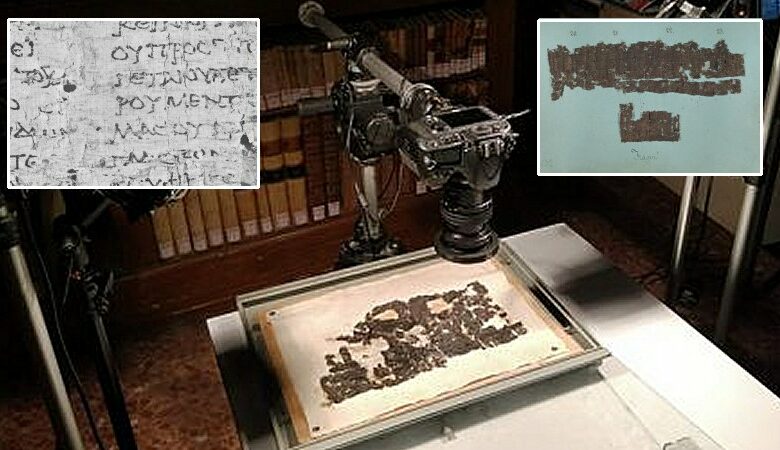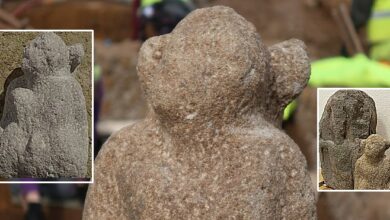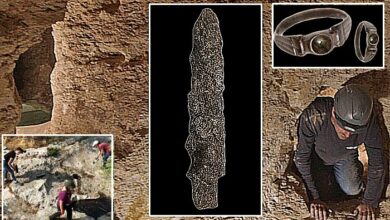Carbonized Herculaneum Papyrus Begins Revealing Its Ancient And Historical Secrets

Conny Waters – AncientPages.com – The carbonized Herculaneum papyrus has yielded a remarkable discovery, with over 1000 words, constituting 30% of the text that emerged from this ancient and historical document.
Charred papyri. Image source
This significant portion contains the History of the Academy by Philodemus of Gadara (110-after 40 BC). This remarkable achievement was made possible through the technological advancements and innovative study methodologies employed within the ‘GreekSchools’ project.
The progress of this groundbreaking research has been presented in Naples, at the esteemed ‘Vittorio Emanuele III’ National Library, marking a significant milestone in the pursuit of uncovering the historical treasures embedded within these ancient artifacts.
The project, in addition to assessing the preservation status of the artifacts in question, aims to publish an updated edition of Philodemus’ Review of the Philosophers, the oldest extant history of Greek philosophy in our possession.
It will be possible through the application of imaging techniques and philological methodologies.
It’s important to stress that the History of the Academy encompasses exclusive information regarding Plato and the development of the Academy under his successors.
 Image source
Image source
“Compared to previous editions, there is now an almost radically changed text, implying a number of new and concrete facts about various academic philosophers,” said Graziano Ranocchia.
“Through the new edition and its contextualization, scholars have arrived at unexpected deductions of interdisciplinary scope for ancient philosophy, Greek biography and literature and the history of the book.”
The project, which commenced in 2021, is a collaborative endeavor led by Graziano Ranocchia from the University of Pisa. This collaboration extends to the Institute of Cultural Heritage Sciences (Cnr-Ispc), the ‘Antonio Zampolli’ Institute of Computational Linguistics (Cnr-Ilc) of the National Research Council, and the National Library of Naples. Notably, the National Library of Naples is home to a papyrus, among other artifacts, that survived the Vesuvius eruption in 79 AD.
Kilian Fleischer, the editor of this precious ancient papyrus as part of the GreekSchools project, said that “some previous additions have been replaced, some previously fragmentary passages have been integrated or reread. The increase in text roughly corresponds to the discovery of ten new medium-sized papyrus fragments. The new readings often draw on new and concrete facts about Plato’s Academy, Hellenistic literature, Philodemus of Gadara and ancient history in general.”
Image source
Interesting is, for example, that Plato’s final resting place was the garden designated for him, a secluded area intended for the Platonic school, within the Academy in Athens.
This private place was situated in close proximity to the Museion (or sacellum), a site considered sacred to the Muses, goddesses of literature, science, and the arts in ancient Greek mythology and religion. The place served as the philosopher’s eternal resting ground.
It has been previously established that the philosopher in question was buried within the premises of the Academy (although without specific details).
See also:
2,000-Year-Old Herculaneum Scrolls Will Be Unwrapped And Deciphered
Major Breakthtrough – Ancient Herculaneum Scroll Deciphered For The First Time
However, new information reveals that he was sold as a slave on the island of Aegina, probably already in 404 BC, when the Spartans conquered the island, or in 399 BC, shortly after Socrates’s demise.
Scholars previously held it as a widely accepted notion that Plato had endured a period of servitude in 387 BC during his sojourn in Sicily, where he resided at the court of Dionysius I of Syracuse. Nonetheless, in another section, in a dialogue among diverse characters, Plato expressed himself contemptuously about a certain barbarian musician originating from the region of Thrace.
According to Costanza Miliani of the Cnr-Ispc., the GreekSchools project also has another important goal: to develop methods of investigating manuscripts by employing the most cutting-edge diagnostic imaging techniques currently available.
These methods include infrared and ultraviolet optical imaging, molecular and elemental imaging, thermal imaging, tomography, and digital optical microscopy, among others.
Written by Conny Waters – AncientPages.com Staff Writer






